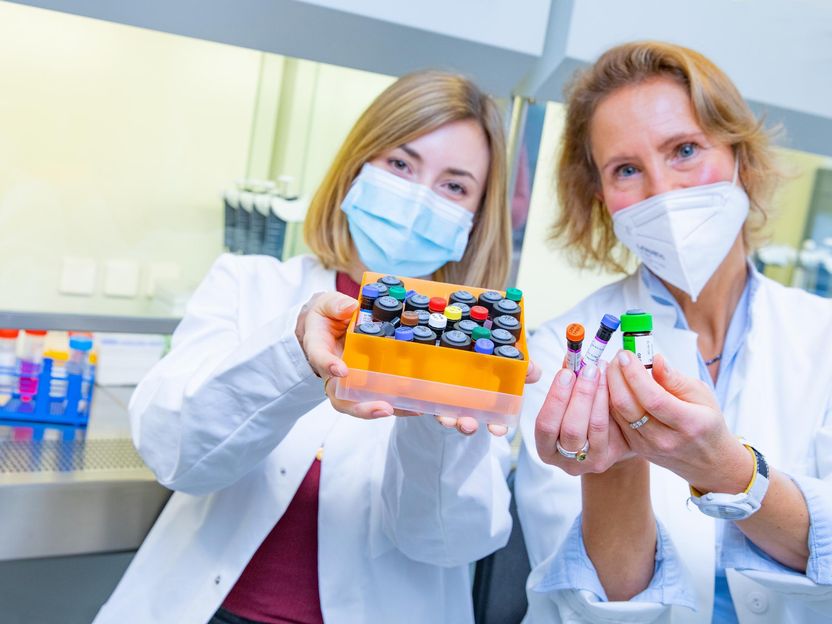How a SARS-CoV-2 infection can become severe COVID-19
Severity is linked to disruption of the endothelial barrier and can be measured by looking at inflammatory and endothelial plasma proteins
Infection with SARS-CoV-2 leaves some people almost unaffected, while others develop life-threatening Covid-19 symptoms. So far, we do not understand exactly why symptoms and disease severity, especially in infections with the original variant, vary so significantly. A team of scientists has now discovered that severe courses of the disease are not only marked by strong immune activation and inflammatory reactions, but also by a dysfunctional endothelium, in other words, the vascular system: If this barrier between blood flow and tissue is damaged, the patient’s condition deteriorates.

They analyze the immune system in detail: Louisa Ruhl (left) and Christine Falk.
K. Kaiser, MHH
‘In our study, we investigated which immune cells are activated in severe cases and in what way the endothelium, in other words the blood vessels, and their activation play a role in the disease progress’, explains Prof. Christine Falk, Scientist at the Hanover Medical School (MHH) and the German Center for Infection Research (DZIF). Many clinical symptoms, such as the destruction of blood vessels in the lungs and acute respiratory distress syndrome, pointed to an impact on the endothelium.
The endothelium is a thin layer of cells that line blood vessels, forming a barrier between blood flow and the surrounding tissues. Infection with SARS-CoV-2 appears to cause strong activation of immune and endothelial cells in the lungs, resulting in the release of various soluble plasma proteins. Severe COVID-19 cases are associated with a dysfunction of the endothelium, wherein the barrier between the alveoli and the surrounding vessels is no longer intact.
The scientists studied 25 patients with severe COVID-19 and 17 recovered patients in the intensive care unit (ICU). They were able to prove that the severity of the disease is linked to disruption of the endothelial barrier and can be measured by looking at inflammatory and endothelial plasma proteins. A pattern of seven plasma proteins appears to be associated with a severe form of the disease, which is characterised by strong inflammatory processes and in which the endothelium is permanently damaged. Furthermore, recovery from severe COVID-19 cases seems to be related to the regeneration of this endothelial barrier.
Which immune cells were detected in the COVID-19 ICU patients? The study showed excessive activation of T-lymphocytes and natural killer cells as well as development of memory T-cells and strong proliferation of plasmablasts, cells that can produce large amounts of antibodies. Furthermore, ICU patients infected with SARS-CoV-2 had high titres of spike- and nucleocapsid-specific antibodies. The researchers found particularly interesting that the immune cell phenotype of these patients mainly changed over time and was less related to progressive severity of the disease. The progression of COVID-19, on the other hand, was closely linked to increased levels of various soluble plasma proteins, namely certain inflammatory mediators and especially endothelial factors.
‘We were able to demonstrate that ICU patients with COVID-19 can be divided into different groups based on their plasma protein profile, which are associated with disease severity’, explains lead author Louisa Ruhl, a PhD doctoral student at MHH. This finding is of great importance for identification of potential biomarkers for severe COVID-19 courses as well as for the development and use of new therapeutic concepts.
Christine Falk’s team now wants to investigate which elements of the immune system lead to activation and damage of the endothelium and whether the strong activation of the immune system also leads to the development of virus-specific T-lymphocytes that can recognise and destroy infected cells and thus contribute to overreaction. Moreover, the study has shown that there are also shifts in the immune cell repertoire in recovered ICU patients with COVID-19. This could be related to the development of Long-COVID cases. These aspects are currently being promoted as part of the COFONI initiative of the state of Lower Saxony with a Fasttrack and a Flexfund project. In collaboration with partners from pneumology (Prof. Tobias Welte, MHH and DZL) and neurology (Prof. Günter Höglinger, MHH), they are not only investigating as to whether the endothelial inflammation with the overreaction of the T-lymphocytes and natural killer cells causes lasting damage, but also to what extent the regeneration of the lung is impaired and the nervous system is affected.
Original publication
Ruhl L; Pink I; Kühne JF; Beushausen K; Keil J; Christoph S; Sauer A; Boblitz L; Schmidt J; David S; Jäck HM; Roth E; Cornberg M; Schulz TF; Welte T; Höper MM and Falk C; "Endothelial dysfunction contributes to severe COVID-19 in combination with dysregulated lymphocyte responses and cytokine networks"; Sig Transduct Target Ther 6, 418 (2021)






















































